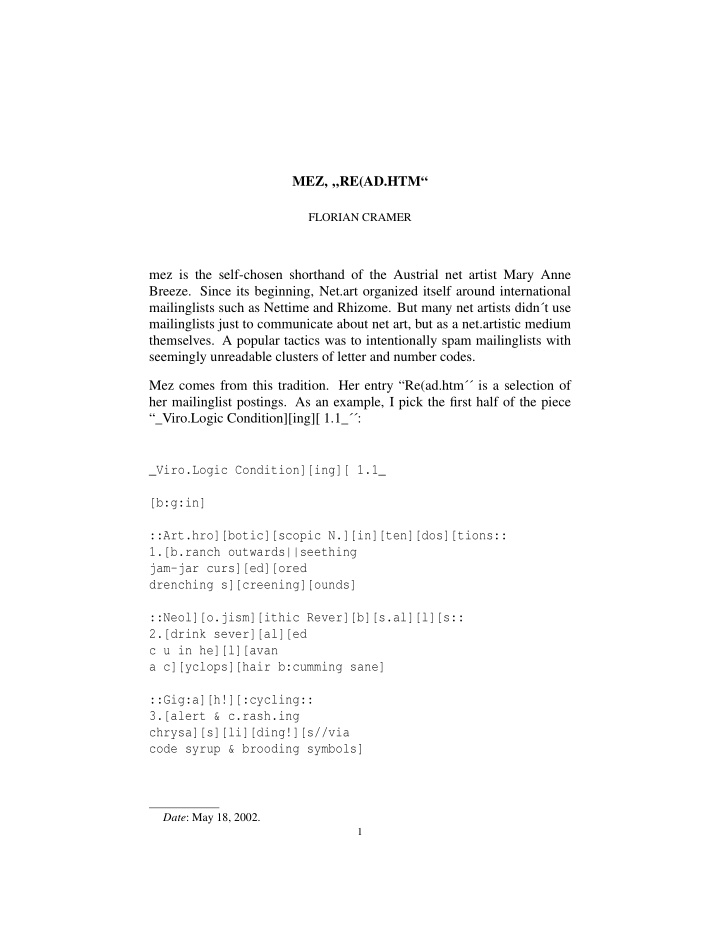



MEZ, „RE(AD.HTM“ FLORIAN CRAMER mez is the self-chosen shorthand of the Austrial net artist Mary Anne Breeze. Since its beginning, Net.art organized itself around international mailinglists such as Nettime and Rhizome. But many net artists didn´t use mailinglists just to communicate about net art, but as a net.artistic medium themselves. A popular tactics was to intentionally spam mailinglists with seemingly unreadable clusters of letter and number codes. Mez comes from this tradition. Her entry “Re(ad.htm´´ is a selection of her mailinglist postings. As an example, I pick the first half of the piece “_Viro.Logic Condition][ing][ 1.1_´´: _Viro.Logic Condition][ing][ 1.1_ [b:g:in] ::Art.hro][botic][scopic N.][in][ten][dos][tions:: 1.[b.ranch outwards||seething jam-jar curs][ed][ored drenching s][creening][ounds] ::Neol][o.jism][ithic Rever][b][s.al][l][s:: 2.[drink sever][al][ed c u in he][l][avan a c][yclops][hair b:cumming sane] ::Gig:a][h!][:cycling:: 3.[alert & c.rash.ing chrysa][s][li][ding!][s//via code syrup & brooding symbols] Date : May 18, 2002. 1
MEZ, „RE(AD.HTM“ 2 What seems like an unreadable mess at first, turns out to be subtle and dense if you read closer. The whole text borrows from conventions of programming languages; it presents itself as a program with a title, ver- sion number, main routine – indicated with the line “[b:g:in]´´ – and sev- eral subroutines or objects (which, like in the programming language Perl, are indicated with two double colons). But the main device are the square brackets which, like in Boolean search expressions, denote that a text can be read in multiple ways. For example, the title reads simultaneously as “Virologic Condition´´, “Virologic Conditioning´´, “Logic Condition´´ and “Logic Conditioning´´. This technique reminds of the portmanteau words of Lewis Carroll and James Joyce’s “Finnegans Wake´´, but is reinvented here in the context of net culture and computer programming. As the four readings of the title tell already, this particular text is about humans and machines and about a sickness condition of both. The square bracket technique is used to keep the attributions ambiguous. For example, the two words in the line “::Art.hro][botic][scopic N.][in][ten][dos][tions::´´ can be read as “arthroscopic´´ / “art robotic´´ / “Arthrobotic´´ / “horo- scopic´´ and “Nintendos´´ / “intentions´´ or “DOS´´. So the machine be- comes arthritic, sick with human desease, and the human body becomes infected with a computer virus; in the end, they recover by “code syrup & brooding symbols´´. So mez has taken ASCII Art, as we can see it in the exhibition above, and Net.art code spamming and refined it from pure visual patterns into a rich semantical private language. She calls it mezangelle which itself is a mez hybrid for her own name and the word “to mangle´´. But why did we accept and shortlist the piece as software art? In the jury, we defined software art as algorithmic code and/or reflections of cultural con- cepts of software. In my opinion, mez´ work fits both parts of the definition. Since her square-bracketted expressions expand into multiple meanings, they are executable, that is, a combinatory sourcecode which generates out- put. But it’s also a sophisticated reflection of cultural concepts of software which rereads the coding convetions of computer programming languages as semantical language charged with gendered politics. It’s imaginary soft- ware which executes in the minds of computer-literate human readers, not unlike the Turing Machine which was an imaginary piece of hardware. So one could put mez’ work as well into the context of code poetry, like the many poetry written in the programming language Perl in the early 1990s, which to the largest extent was also pseudo-code that didn’t actually execute
MEZ, „RE(AD.HTM“ 3 on a machine. But while most of this classical code poetry was kitschy haikus and highschool love poetry, mez succeeds in rewriting code poetry into contemporary art in the best sense of the word.
Recommend
More recommend